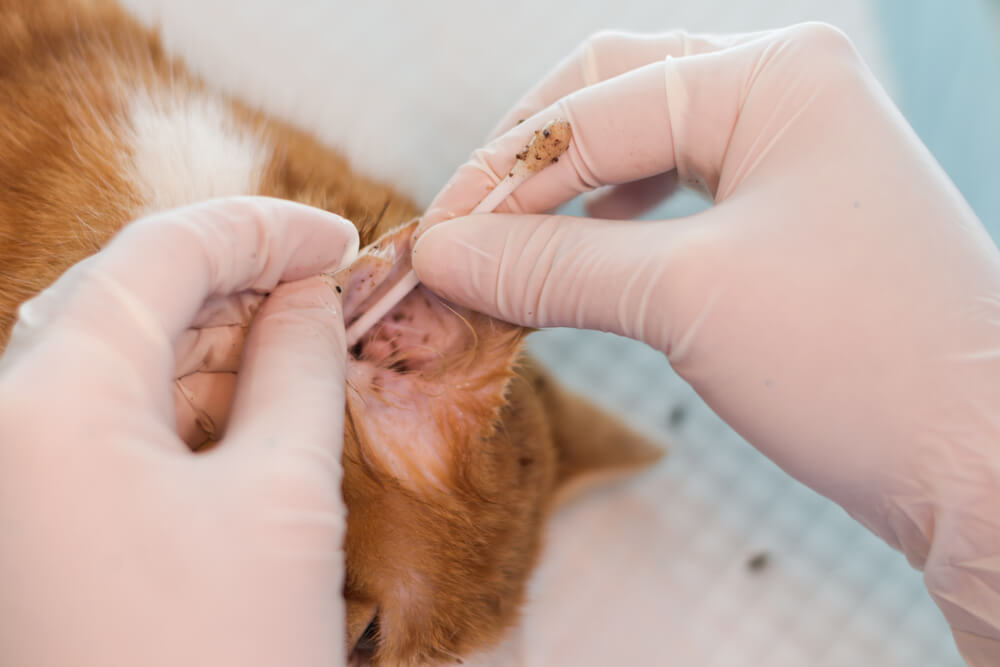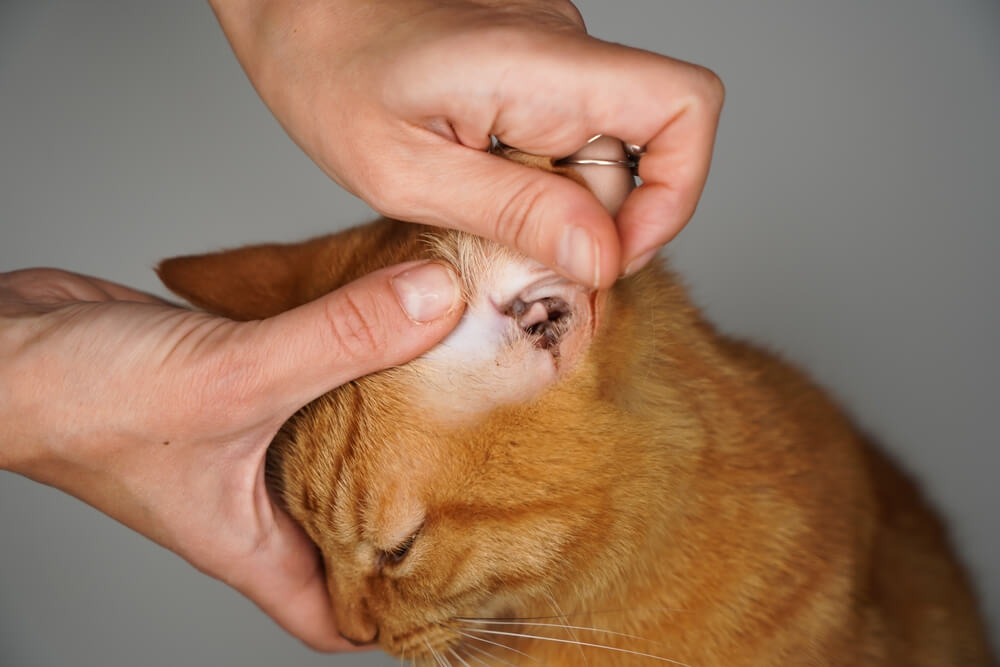Ear mites are a common problem for cats, causing discomfort. Understanding these parasites is crucial for effective treatment. This guide covers symptoms of infestations, treatment options including medications and home remedies, and preventive measures to protect your cat. It also highlights the importance of follow-up care for complete recovery, helping you safeguard your pet’s health.
Signs Your Cat Might Have Ear Mites
Ear mites are a common concern for cat owners, and recognizing the symptoms early can help ensure your feline friend receives prompt treatment. One of the primary signs of ear mites in cats is persistent itching around the ears. If you notice your cat frequently scratching its ears or shaking its head, it might be time to investigate further.
Another key symptom of ear mites is a dark, crumbly discharge that resembles coffee grounds in your cat’s ears. This discharge is often accompanied by an unpleasant odor, which can be a strong indicator of an infestation. Additionally, inflamed or red inner ears are common signs that your cat may be dealing with these pesky parasites.
Behavioral changes can also hint at ear mite issues. Cats with ear mites might become more irritable due to the discomfort caused by constant itching and irritation. If you observe any of these symptoms (persistent scratching, unusual discharge, inflammation, or behavioral shifts) it’s crucial to take action and consult your veterinarian for proper diagnosis and treatment options.
Detecting ear mites early not only alleviates discomfort for your feline companion but also prevents potential complications such as bacterial infections or damage to the ear canal. Keeping an eye out for these telltale signs ensures that you can provide timely care and maintain your cat’s overall health and well-being.
How Veterinarians Confirm an Ear Mite Infestation

When it comes to diagnosing cat ear mites, veterinarians follow a systematic approach to ensure accurate identification and effective treatment. The process typically begins with a thorough veterinary check-up for ear mites, where the vet examines your cat’s ears for telltale signs of infestation, such as excessive scratching, head shaking, or dark debris resembling coffee grounds.
To confirm their suspicions, veterinarians often perform a microscopic examination for ear mites. This involves gently swabbing the inside of your cat’s ear and transferring the sample onto a slide. Under the microscope, these tiny parasites become visible as they move about in their characteristic manner. This step is crucial because it not only confirms the presence of ear mites but also helps rule out other potential causes of similar symptoms, such as bacterial or yeast infections.
By following this detailed diagnostic process, veterinarians can provide an accurate diagnosis and recommend an appropriate treatment plan to alleviate your pet’s discomfort and eradicate the infestation effectively.
Medications and Home Remedies to Eliminate Ear Mites
When it comes to addressing the discomfort caused by ear mites in cats, there are several treatment options available that range from medications to home remedies. Understanding these options can help pet owners make informed decisions about their cat’s health.
For those seeking medical solutions, over-the-counter treatments for cat ear mites are a popular choice. These treatments often contain insecticides specifically designed to eliminate mites and provide relief from itching and irritation. Products such as drops or topical ointments can be applied directly into the cat’s ear canal, effectively targeting the source of the problem.
In addition to pharmaceutical options, many pet owners explore natural remedies for feline ear mite removal. These remedies often involve ingredients found at home or in nature that possess soothing properties. For instance, using olive oil as a gentle cleanser can help dislodge debris and suffocate mites when used consistently over time. Similarly, diluted apple cider vinegar is another home remedy known for its potential to create an unfavorable environment for mites.
Home remedies for cat itchy ears not only focus on eliminating the mites but also on alleviating discomfort caused by scratching and inflammation. Aloe vera gel is renowned for its soothing properties and can be applied around the outer ear area to reduce irritation.
Before starting any treatment, it’s essential to consult with a veterinarian to ensure safety and effectiveness based on your cat’s specific needs. Whether opting for conventional medications or exploring natural alternatives, addressing ear mite infestations promptly is crucial in maintaining your feline friend’s comfort and well-being.
Tips to Protect Your Cat from Future Infestations
Preventing ear mites and future infestations in cats requires a proactive approach that focuses on regular grooming and a clean environment. One of the most effective strategies is to incorporate routine checks into your cat’s grooming regimen. Regularly inspect your cat’s ears for any signs of irritation or unusual discharge, which could indicate the presence of ear mites. Gently cleaning your cat’s ears with a vet-approved solution can help prevent the accumulation of wax and debris that might attract these pests.
In addition to regular grooming, maintaining a clean living space is crucial. Ensure that your cat’s bedding is washed frequently and vacuum areas where your pet spends most of its time to remove any potential mites or eggs from carpets and furniture. It’s also beneficial to keep an eye on interactions with other animals, as ear mites are highly contagious between pets.
Finally, scheduling regular veterinary check-ups can be invaluable in preventing infestations before they start. Your vet can provide tailored advice on preventive treatments such as topical medications or ear drops that deter mites effectively. By following these tips, you can significantly reduce the risk of ear mite infestations and keep your feline friend healthy and comfortable.
The Importance of Follow-Up Care and Monitoring After Treatment
After treating a cat for ear mites, it’s crucial to understand the importance of follow-up care and monitoring to ensure a full recovery. Post-treatment care for cats with ear mites involves more than just administering medication; it requires vigilant observation and ongoing attention.
Monitoring recovery from a cat mite infestation is essential to confirm that the treatment was effective. This involves regularly checking your cat’s ears for any signs of lingering mites or infection, such as redness, swelling, or discharge. It’s important to continue cleaning your cat’s ears as advised by your veterinarian to remove any remaining debris and prevent re-infestation.
Ensuring successful eradication of ear mites in felines means following through with all prescribed treatments and attending any follow-up appointments scheduled by your vet. These check-ups allow the vet to assess the effectiveness of the treatment and make adjustments if necessary. By being proactive in post-treatment care, you can help ensure that your feline friend remains healthy and comfortable long after the initial infestation has been resolved.
Taking Action Against Ear Mites to Ensure Your Cat’s Comfort and Health
In conclusion, taking proactive steps against ear mites is essential to ensure your cat’s comfort and health. Ear mites are tiny parasites that can cause significant discomfort and lead to more severe health issues if left untreated. Regularly checking your cat’s ears for signs of infestation, such as excessive scratching, head shaking, or dark discharge, is crucial for early detection.
Once identified, a visit to the veterinarian will help confirm the presence of ear mites and determine the appropriate treatment plan. Treatments often include topical medications that effectively eliminate the mites and soothe any inflammation or irritation caused by their presence.
Beyond treatment, preventive measures play a critical role in maintaining your cat’s ear health. Regular cleaning of your cat’s ears with vet-approved solutions can help prevent future infestations. Additionally, keeping your pet’s environment clean and ensuring they have regular veterinary check-ups will further protect them from these pesky parasites.
By taking these actions against ear mites, you not only alleviate immediate discomfort but also contribute to your cat’s long-term well-being. Prioritizing their ear health is an important aspect of responsible pet ownership that ensures they remain happy and healthy companions.



